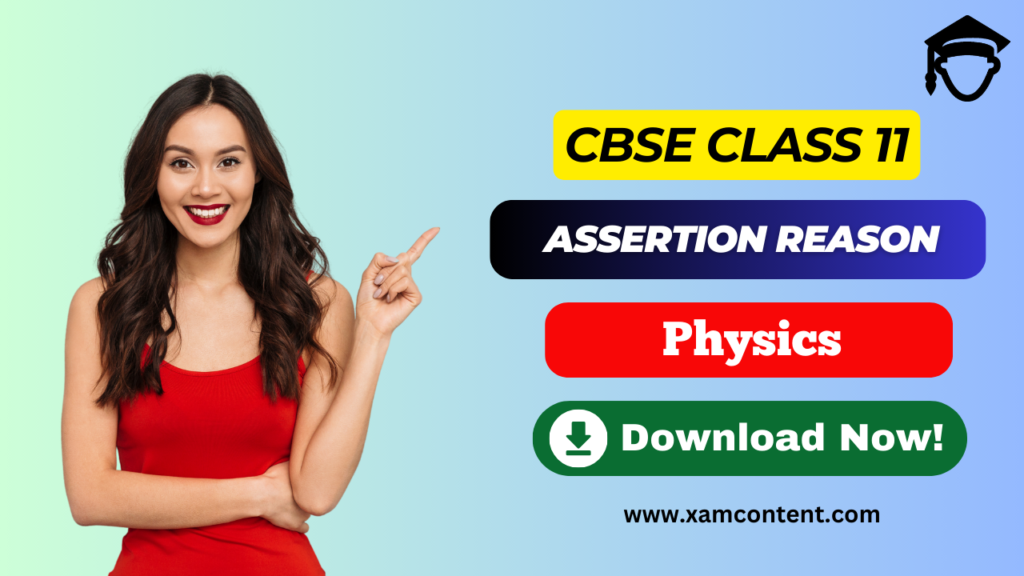Last Updated on April 24, 2025 by XAM CONTENT
Hello students, we are providing assertion reason questions for class 11. Assertion Reason questions are the new question format that is introduced in CBSE board. The resources for assertion reason questions are very less. So, to help students we have created chapterwise assertion reason questions for class 11 Physics. In this article, you will find assertion reason questions for CBSE Class 11 Physics Chapter 6 System of Particles and Rotational Motion. It is a part of Assertion Reason Questions for CBSE Class 11 Physics Series.
| Chapter | System of Particles and Rotational Motion |
| Type of Questions | Assertion Reason Questions |
| Nature of Questions | Competency Based Questions |
| Board | CBSE |
| Class | 11 |
| Subject | Physics |
| Useful for | Class 11 Studying Students |
| Answers provided | Yes |
| Difficulty level | Mentioned |
| Important Link | Class 11 Physics Chapterwise Assertion Reason |
Assertion Reason Questions on System of Particles and Rotational Motion
Assertion Reason Questions
Directions:
Each of the following questions consists of two statements: an Assertion (A) and a Reason (R). Answer them by selecting the correct option:
(a) Both Assertion (A) and Reason (R) are true, and Reason (R) is the correct explanation of Assertion (A).
(b) Both Assertion (A) and Reason (R) are true, but Reason (R) is not the correct explanation of Assertion (A).
(c) Assertion (A) is true, but Reason (R) is false.
(d) Assertion (A) is false, but Reason (R) is true.
Q1. Assertion (A): The center of mass of a uniform semicircular ring lies at its geometric center.
Reason (R): The center of mass always lies at the center of the figure.
Answer: (c) Assertion is false, but Reason is true.
Difficulty Level: Tough
Q2. Assertion (A): A body can rotate even if its center of mass remains at rest.
Reason (R): Torque causes rotational motion, independent of translational motion.
Answer: (a) Both A and R are true, and R is the correct explanation of A.
Difficulty Level: Moderate
Q3. Assertion (A): Moment of inertia depends on the distribution of mass and the axis of rotation.
Reason (R): Moment of inertia is a scalar quantity.
Answer: (c) Assertion is true, but Reason is false.
Difficulty Level: Moderate
Q4. Assertion (A): Angular momentum of a system is conserved in the absence of external torque.
Reason (R): Torque is the time derivative of angular momentum.
Answer: (a) Both A and R are true, and R is the correct explanation of A.
Difficulty Level: Moderate
Q5. Assertion (A): The radius of gyration of a body is equal to the distance of its center of mass from the axis of rotation.
Reason (R): Radius of gyration is defined as the distance from axis at which mass may be assumed to be concentrated.
Answer: (b) Both A and R are true, but R is not the correct explanation of A.
Difficulty Level: Tough
Also check
- Waves Class 11 Assertion Reason Questions Physics Chapter 14
- Oscillations Class 11 Assertion Reason Questions Physics Chapter 13
- Kinetic Theory Class 11 Assertion Reason Questions Physics Chapter 12
- Thermodynamics Class 11 Assertion Reason Questions Physics Chapter 11
- Thermal Properties of Matter Class 11 Assertion Reason Questions Physics Chapter 10
- Mechanical Properties of Fluids Class 11 Assertion Reason Questions Physics Chapter 9
- Mechanical Properties of Solids Class 11 Assertion Reason Questions Physics Chapter 8
- Gravitation Class 11 Assertion Reason Questions Physics Chapter 7
- System of Particles and Rotational Motion Class 11 Assertion Reason Questions Physics Chapter 6
- Work, Energy, and Power Class 11 Assertion Reason Questions Physics Chapter 5
- Laws of Motion Class 11 Assertion Reason Questions Physics Chapter 4
- Motion in a Plane Class 11 Assertion Reason Questions Physics Chapter 3
- Motion in a Straight Line Class 11 Assertion Reason Questions Physics Chapter 3
- Units and Measurements Class 11 Assertion Reason Questions Physics Chapter 2
🚀 Boost Your Exam Prep: Get assertion reason questions for all subjects (Class 6-12) now!
👉 Explore more resources on CBSE Class 11
Topics from which assertion reason questions may be asked
- Centre of mass of a system of particles
- Moment of inertia and torque
- Angular momentum and its conservation
The center of mass of a system moves like a single particle under external force.
Assertion reason questions from the above given topic may be asked.

Frequently Asked Questions (FAQs) on System of Particles and Rotational Motion Assertion Reason Questions Class 11
Q1: What is the importance of System of Particles and Rotational Motion in Class 11 Physics?
A1: It forms the basis for various real-life applications and is crucial for JEE/NEET level conceptual clarity.
Q2: Are assertion reason questions asked in CBSE exams?
A2: Yes, CBSE has introduced competency-based formats which include assertion reason questions to test conceptual understanding.
Q3: How to prepare assertion reason questions from System of Particles and Rotational Motion?
A3: Focus on key definitions, cause-effect relationships, and conceptual reasoning instead of just memorizing facts.
Q4: Can numerical topics appear in assertion reason format?
A4: Yes, concepts from numerical topics like laws, formulas, or effects of parameter change are often asked.
Q5: Where can I find more assertion reason questions on System of Particles and Rotational Motion?
A5: Visit xamcontent.com and physicsgurukul.com for chapterwise assertion reason question collections.


